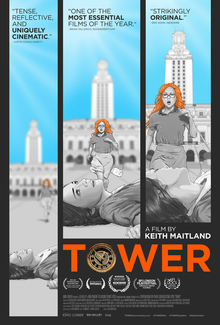
Pretty much everything that I watch has been readied for weeks or even months in advance just waiting for me to get to it. Since we usually only watch something like two to three films a week, it can be a while before I get to a title. All this is to say that I had been planning to watch this title way before the Las Vegas shooting early this month but doing so in its wake like this does give the experience some added weight and relevance.
The overly generic title doesn’t make it obvious but this is a documentary about the shooting at the University of Texas, Austin, US in 1966. Since that took a place a long time ago, most of this film consists of a reenactment made using rotoscopic animation. supplemented by some archival footage of the event. The focus is placed squarely on the survivors of the attack, such as Claire Wilson, a pregnant woman who was the first to be shot from the tower; Aleck Hernandez, a teenager delivering newspapers on a bicycle; Allen Crum, a bookstore manager who went outside to help a victim and ended up ascending the tower with the police; police officers Ramiro Martinez and Jerry Day who also ascended the tower and some others. The film recounts their experiences from the initial shots that were fired, right up to the moment when the shooter Charles Whitman and the aftermath. It is noteworthy that the film goes out of its way to avoid giving too much attention to Whitman, probably in line with the modern thinking that we shouldn’t glorify these villains.
Some interesting documentary filmmaking techniques are deployed here to bring the events of the day to life. Naturally director Keith Maitland sought out and interviewed the survivors for this project but rather than using their real voices, for the most part he hired actors to play them and read their lines. He does draw your attention to the fact that he did so in the final interviews which do show the real persons so there’s no dishonesty here. But the fact is that unlike traditional documentaries, most of the footage used here is artificially created. You can even notice slight differences in the dialogue between the original interviews and how the actors chose to interpret the lines. In this instance it works great and most people would agree that it is faithful to the accounts of the real survivors but I think we should all be conscious of how such creative freedom could easily be used to give a misleading impression.
It’s hard to argue against the results however as the film comes as close as it’s possible to imagine to taking the audience to that fateful day. What is especially striking is the sense of sheer disbelief and confusion among many of the people at that time given the novelty of mass shootings then. Two students actually moved towards the tower thinking that someone was just playing pranks with an air-gun. Many others severely underestimated the range, accuracy and deadliness that the shooter could achieve. This certainly wouldn’t happen today as the US has grown used to mass shootings. Indeed one Broken Forum was in Las Vegas during the recent one and immediately concluded that a shooting was going on when he saw the crowd moving. The incident portrayed in this film is also similar to the most recent one as both involved sniper perched at a high vantage point. This documentary also shows civilians showing up with their own guns to shoot at the tower once the news got out about what was going on but makes it clear how futile this is. I’d even argue that this did more harm than good as it exposed the police officers who ascended the tower to harm and added to the confusion.
One problem is that as Tower focuses exclusively on the accounts of the survivors, it doesn’t tell the stories of many of those who died. This creates a gap in the narrative as it isn’t exactly clear from this film how Whitman ascended the tower with all his guns. I guess this is because he killed most of the people who had witnessed him going up. Another problem is that while it reminds us that many other shootings have taken place since 1966, the film actively refuses to get into the debate over gun control. No doubt it wishes to avoid political controversy but the fact that for example Whitman had used bad checks to buy a carbine and plentiful ammunition the morning of the shooting seems like an important piece of information that is missing. The film ends with Claire Wilson saying that she forgives Whitman. I don’t want to detract from the value of their accounts or the horror that they experienced and I can appreciate how important it is for the survivors to find some resolution. But it seems silly and overly sentimental to me for the film to end on that note when mass shootings have become a regular event in the US and they should be trying to find a solution to it rather than accepting it as an inevitable fact of life.
There’s no doubt in my mind that Tower is an excellently made documentary about an important event in the history of the US. Still it feels weird to me that it took fifty years for it to get made and many other mass shootings have since eclipsed the horror of this particular event. Seeing those 1960s era cars, the radios, how the police react and so on seems almost quaint now and so at odds with the tragedy of the day.